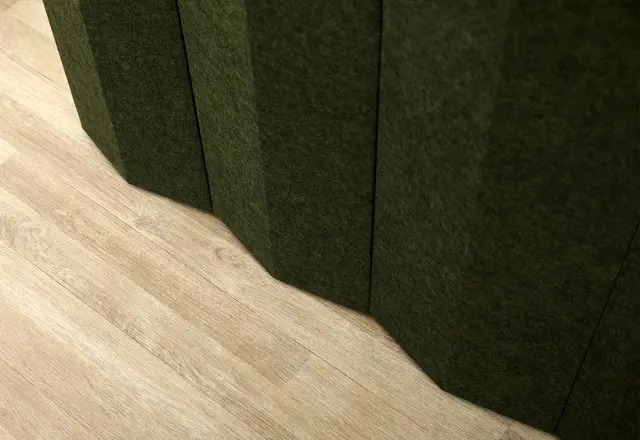For Warren and Mahoney’s new Melbourne design studio, Lanes acoustic panels are a flexible, culturally appropriate and effective solution.
When it came to designing their new Melbourne design studio in the heritage Queen & Collins building, Warren and Mahoney brought together Māori and First Nations cultures within the neo-Gothic space. The art has been to create a workplace where Indigenous philosophies and stories are encoded symbolically and experientially, and where cultural diversity is nurtured.
Founded in New Zealand in the 1950s, and working in Australia for over a decade now, Warren and Mahoney engaged Indigenous architect Jefa Greenaway of Greenaway Architects to co-design the space with their Melbourne team and principal Whare Timu (Ngāti Kahungunu, Te Arawa, Ngāti Tūwharetoa).

Traditional and modern materials articulate rituals and spaces to tell a layered story of people and place. Charred timber, spotted gum joinery, glass and textiles, along with decorative acoustic wall panels by Autex Acoustics differentiate the work zones into Showtime, Airtime, Playtime and My Time. From the ochre-coloured central collaboration space to quiet perimeter rooms, the studio caters to a variety of working modalities.
“We have a calm, recessive backdrop to allow the amplification of the cultural narratives,” says Warren and Mahoney associate and project architect, Marianne Calvelo. “We identified relationships between the three cultures in rituals and procession, also in geometries and material expressions. They sit naturally side by side and in places they have been combined.”

The neutral backdrop is defined by the Lanes acoustic panel system in Gherkin and Opera – colours that extend in paint onto the heritage walls and arched window niches. The 3D form of Lanes Peak creates visual depth in its undulating shadow lines, while the hidden air gap provides exceptional acoustic performance.
Acoustic design critical for adjacencies
“When specifying acoustic panels for this type of project, first and foremost we have to achieve a noise reduction coefficient of 0.8–0.9,” explains Calvelo. “The other dimension is the sound transmission class [STC] to reduce or eliminate sound travelling between rooms. The acoustic engineer gave us the optimal STC values to keep conversations private – for example, when a meeting room or a private room is next to a workspace.
“The main staff social space is near the front entrance and next to the boardroom. People can be having lunch, laughing away, and you can’t hear them in the boardroom. It’s fantastic. Carpet and curtains help, but the Autex product does the heavy lifting, allowing various activities to happen simultaneously close by.”
With the more frequent online and hybrid meetings of today, and the need to entice staff back into the physical workplace, the office environment needs to work harder than ever. A comfortable, home-like environment helps – with a social kitchen, dining space and soft seating – as do exceptional studio and collaboration spaces. The interior here uplifts and enhances the experience of sharing, ideation and debate through excellence in design, furniture, lighting and acoustics.
Adding layers to a heritage shell
Part of the wider Queen & Collins development in Melbourne’s CBD, Warren and Mahoney’s space is located in the historic Gothic Bank, built in 1883-87 and also a listed building under the National Trust of Australia. Working with heritage building fabric required great care.
“The easy, clip-on system of the Lanes panels allowed a light touch to existing walls,” notes Calvelo. “We can easily swap a panel should one get damaged, and we can unclip the wall surface if we need to access services behind it. The great thing about Lanes is this flexibility. The pattern can be set out from one edge; it can be detailed to turn a corner or to have an infill piece to close.”
The design team worked with Autex Acoustic’s technical lead to learn about all the finer construction and set-out details. Autex then used the architectural plans to create a spreadsheet of every panel for design coordination. Once onsite, Autex supplied shop drawings for coordination, and the Warren and Mahoney team worked out some of the bespoke details with the fitout team.
Clipping system allows for acoustic air gap and end-of-life options

Lanes is attached with an adhesive-free clipping system. This allows a hidden air gap, which helps to increase sound absorption, enhancing the acoustics of working environments by up to 80%. It is also the first (and only) ‘air gap’ system of its kind that is fire tested per Australian standard AS ISO9705-2003, achieving a Group 1 classification.
Made using at least 60% recycled PET content, Lanes is a sustainable and carbon-neutral solution. In addition to ease of installation, the clipping system allows for easy disassembly, after which Lanes can be reused or – thanks to the absence of contaminating adhesives – recycled.
Project details
Project: Warren and Mahoney’s new Melbourne design studio
Architect: Warren and Mahoney in association with Greenaway Architects
Installer: ACM Interiors
Interior Designers: Warren and Mahoney in association with Greenaway Architects
Builder: Urbancore
Specification Manager: Bianca Haszard
Featured Product: Lanes acoustic panels
Photographer: Shannon McGrath

